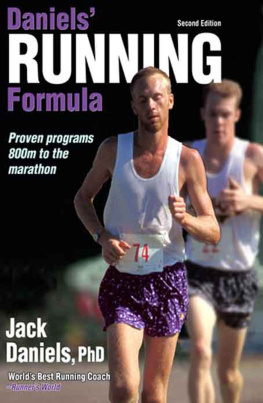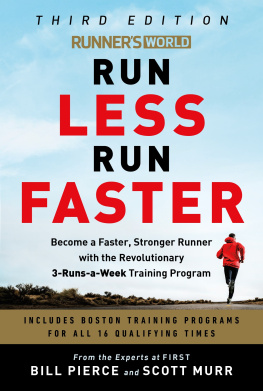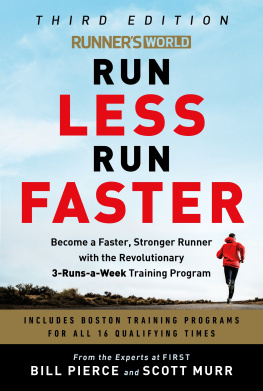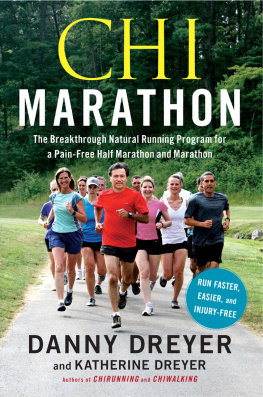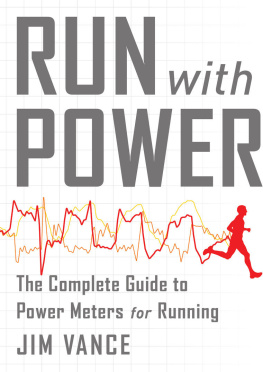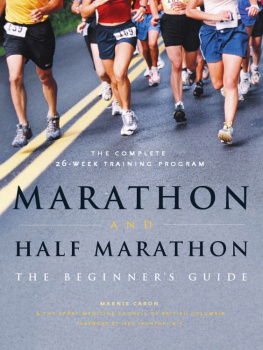
Library of Congress Cataloging-in-Publication Data
Daniels, Jack, 1933-
Daniels running formula / Jack T. Daniels.-- 2nd ed.
p. cm.
Includes index.
ISBN 0-7360-5492-8 (soft cover)
1. Running. 2. Running--Training. I. Title.
GV1062.D36 2005
796.42--dc22 2004007091
ISBN: 0-7360-5492-8
Copyright 2005, 1998 by Jack Tupper Daniels
All rights reserved. Except for use in a review, the reproduction or utilization of this work in any form or by any electronic, mechanical, or other means, now known or hereafter invented, including xerography, photocopying, and recording, and in any information storage and retrieval system, is forbidden without the written permission of the publisher.
Notice: Permission to reproduce the following material is granted to instructors and agencies who have purchased Daniels Running Formula, Second Edition: pp. 107 and 108. The reproduction of other parts of this book is expressly forbidden by the above copyright notice. Persons or agencies who have not purchased Daniels Running Formula, Second Edition may not reproduce any material.
Acquisitions Editor: Martin Barnard; Developmental Editor: Julie Rhoda; Assistant Editor: Carla Zych; Copyeditor: John Wentworth; Proofreader: Annette Pierce; Indexer: Betty Frizll; Permission Manager: Toni Harte; Graphic Designer: Nancy Rasmus; Graphic Artist: Kim McFarland; Photo Manager: Dan Wendt; Cover Designer: Keith Blomberg; Photographer (cover): Andy Lyons/Getty Images; Photographer (interior): Photos courtesy of the author except where otherwise noted; Art Manager: Kareema McLendon; Illustrator: Tom Roberts; Printer: Versa Press
Human Kinetics books are available at special discounts for bulk purchase. Special editions or book excerpts can also be created to specification. For details, contact the Special Sales Manager at Human Kinetics.
About the cover photo: 2000 and 2004 U.S. Olympian Alan Culpepper races in the 2000 U.S. Olympic trials.
Printed in the United States of America 10 9 8 7 6 5 4 3 2
Human Kinetics
Web site: www.HumanKinetics.com
United States: Human Kinetics
P.O. Box 5076
Champaign, IL 61825-5076
800-747-4457
e-mail:
Canada: Human Kinetics
475 Devonshire Road Unit 100
Windsor, ON N8Y 2L5
800-465-7301 (in Canada only)
e-mail:
Europe: Human Kinetics
107 Bradford Road
Stanningley
Leeds LS28 6AT, United Kingdom
+44 (0) 113 255 5665
e-mail:
Australia: Human Kinetics
57A Price Avenue
Lower Mitcham, South Australia 5062
08 8277 1555
e-mail:
New Zealand: Human Kinetics
Division of Sports Distributors NZ Ltd.
P.O. Box 300 226 Albany
North Shore City
Auckland
0064 9 448 1207
e-mail:
To my daughters, Audra Marie and Sarah Tupper, who keep me youthful and zealous about the future, and my loving wife, Nancy Jo, whose presence is a blessing from God.
Contents
T en steps easyten steps hardtwenty steps easytwenty steps hardone hundred steps easyone hundred steps hardthis has been one of my most effective training mantras, and it was taught to me by Jack Daniels.
If the best measure of good training techniques is staying power, then Jack Daniels has set the gold standard. I continue to employ his simple training techniques twenty-four years after meeting Jack in 1980 at Nikes first research lab in Exeter, New Hampshire.
Jack Daniels? I questioned, thinking that his name was a set-up for a punch line. I learned differently soon enough. A gentleman and a scholar, Jack Daniels is the epitome of an exercise physiologist, athletic researcher, and coach, who does it the right waywith scientific data, organization, simple explanations, and heart. Jack deserves all the accolades and praise that he receives from his colleagues in the field of exercise physiology and from those in the running community.
All serious athletes endure periods of subpar performance or injury, and believe me, these periods can be filled with nothing less than self-doubt and panic. How wonderful it has been to know Jack and to have the opportunity to listen to a voice of calm and reason during such times. More often than not, Jack would lay out a sound strategic and proactive plan to overcome the hurdles and obstacles I was facing. Waking up from arthroscopic surgery 17 days before the Olympic Marathon Trials in 1984, I was an emotional wreck. Although I reached out to a number of professionals to help speed my physical recovery, it was Jack Daniels who eased my nerves and provided me with creative and practical techniques to maintain my fitness levelboth physical and emotional. Were it not for the bicycle that Jack mounted on his treadmill for me to pedal with my hands, I would not only have gone berserk, but I would probably have snuck out for a run the day after surgery, thereby ruining my slim chance of healing properly before the upcoming Trials.
Im thrilled that Jack has decided to share his insights and knowledge in this book. I can only hope that others benefit from his expertise as much as I have during my career. Youre in for a comprehensive and easily understood lesson in running, coaching, and exercise physiology.
And when Im passed on the roads by someone mumbling ten steps easyten steps hard, Ill know that the circle has been completed. Enjoy!
Thank you, Jack!
Joan Benoit Samuelson
M y main purpose for writing a book on running was to try to simplify the terminology and workouts so that the same types of training could be used for all categories of runners, from relative beginners to the elite. My motivation, during the 15 years I spent working on the first edition of Daniels Running Formula, was the seeming lack of general training advice that could be used with beginners as well as more accomplished runners.
When I decided to become a runner, after spending my high school and college years as a swimmer, I found that most of the advice I heard and read about came from a coach telling other coaches how his star runner trained. The programs of these stars didnt really seem applicable to runners who were just getting started, or to serious runners who were not yet at a high performance level. More often than not, though, the practice was to train everyone the same way, often too hard, and hope that some would survive (the prevailing attitude being that anyone who couldnt keep up might as well give up on the sport).

